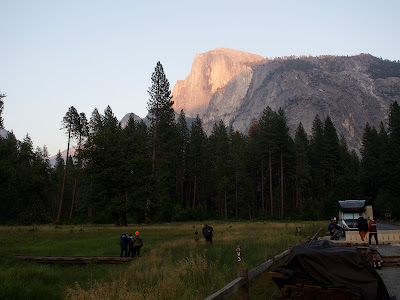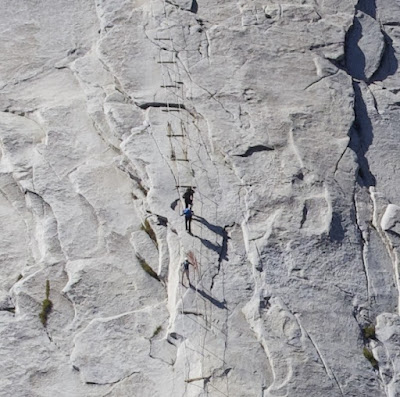My friend Aeneas and I just hiked to the top of Half Dome. The National Park Service has a pretty good page about the route and the experience, if you want to see what the officials say.
Both Aeneas and I had been doing some hiking in the hills for a few weeks prior to our Half Dome excursion, so we didn't really have a problem with the hiking...although we were not speed demons, either. We started our hike at about 7:30 a.m. and got to the top around 1 pm, with about a half hour of stops along the way to eat, drink, take photos, etc. So that's about 2 mph average speed on the way up. We started back down at about 2:30pm and took about 4 hours to get down, arriving just as the valley floor had fallen into shadow while Half Dome was still illuminated by the sun.
I took about 8 pounds of liquids (100 ounces of water in a Camelback, and two 16-ounce bottles of juice) and was glad I did: I ended up drinking most of it, although I had enough left that I gave about 10 ounces to a couple of hikers who had run out while they were still about two hours from the end of the hike. I recommend taking at least three liters of liquids for ordinary conditions, and well over 4 liters if the weather is hot or if you're not in very good shape. If you carry a few extra pounds of water, that's not going to make your day miserable (and you can always dump some if you find you really do have extra, although you should not do this until you are at least part way back). But if you are short a few pounds of water that your body needs, that can make for a miserable or even dangerous experience. I also took a fairly hefty amount of food: nuts, M&Ms, a couple of granola bars, fig bars, a Snickers bar, an apple, plus the 32 ounces of juice that I mentioned...probably about 2500 Calories. That's still far short of what I used on the hike, which was probably over 4000 Calories, but it was plenty to keep me from 'bonking' and although I was a bit hungry when we got back at the end of the day I was never in any distress. Aeneas ate much less than me --- I think just 4 Clif Bars and a few of my fig bars -- and by the time we got back down he was obsessing about food. I guess the point of this whole paragraph is: you are going to be doing 5200 feet of climbing and walking 15-20 miles depending on which route you take, and your body needs a lot of water and food to do an effort like that. This is not the time to try to lose weight, this is the time to give your body what it needs so you can have a good time.
As you can see in the first photo in this post, you start by climbing past a couple of waterfalls. Here's Aeneas with the upper falls (Nevada Falls) in the background. That's not Half Dome over his shoulder, it's a much smaller peak, the one that the route disappears behind in that route photo at the top. As you can see, for this portion -- and all the way up until fairly near the back of Half Dome itself -- we were hiking through dry woodland, mostly whitebark pine and sequoias.
Above, check out these sequoias that have managed to grow in a thin crack in the granite. This is at the top of Nevada Falls.
We didn't see much wildlife, which wasn't really a surprise. The wildlife we did see was very habituated to humans, which also shouldn't be a surprise since there is rarely a 5-minute period in which nobody passes on the trail. Crows, jays, deer, and this Pileated Woodpecker were untroubled by our presence, having presumably seen several hundred people per day almost every day of their lives.
After several hours of hiking we got to the "sub-dome", a mound of granite that forms the approach to Half Dome's backside. The trail switchbacks up via granite steps that are a monumental achievement for Yosemite's trail-builders. Many of the individual rocks weigh hundreds of pounds, and thousands of rocks were placed to make the trail. At this point there are only about 700 vertical feet left to climb, and you're over 8000 feet above sea level. I did notice the thin air, and my pulse was over 140 even though we were taking it quite easy. At this point we had already hiked 10 miles and done 5000 feet of climbing.
The final stretch is up "the cables", an almost comically dangerous segment where you pull yourself up steel cables that are anchored in the rock.
Fatalities here are rare -- I think the most recent one was in 2019 -- but injuries are common, according to the ranger who checked our permit before letting us start up the sub-dome. (You must have a permit. You can get one through lottery, far in advance, if you're lucky; or, like us, you can keep submitting your name in a smaller, daily lottery, and if you are accepted then you climb two days later. We got our approval Wednesday night, drove up Thursday and stayed overnight in the valley, and hiked on Friday).
The cables ought to be not a big deal, and we would have been up them in 15 minutes (for about 400 feet of vertical gain) except for other people. There are people coming down who have to squeeze past, and, more problematic, we were stuck in a sort of traffic jam so we had to keep starting and stopping. In a lot of places it's no big deal to stop and wait for a bit, you can find a place to put your feet (for instance, in the photo above you can see some of the horizontal boards that are placed at intervals), but other places you are standing on an steep face of smooth granite and you have to use your calf muscles and other muscles to stay there, so the stopping made it quite uncomfortable. When we got near the top we discovered that our traffic jam was caused by some twenty-something guy who was freaking out and had to keep pausing for 30 seconds or so to psyche himself up for the next short segment. My suggestion/request is: if you want to prove something to yourself or to others, as far as your ability to conquer your fear of heights, choose someplace where you won't inconvenience other people so much. There are dozens of other cliffs and prominences in Yosemite where you can put yourself in a situation that is just as vertiginous, or even more so, without making other people wait in an awkward, uncomfortable, and somewhat dangerous situation.
To the extent that the cables are actually dangerous, it's mostly because of...well, because of people. Some of the people coming down were rushing and not staying in control; if one of them were to have stumbled and fallen or slid onto me, they might easily have knocked me off the cable I was holding onto. That probably wouldn't have been fatal, although it's not impossible, and it could easily have caused major injuries. Most people were behaving fine, but not everyone.
Fortunately there were no mishaps while we were on the cables. Eventually we got to the top -- after something like 30 minutes on the cables, when it should have been 15 -- and were rewarded by some truly spectacular views. The valley floor is almost 5000 feet below.
We hung out at the top for almost an hour, taking photos and looking around and eating and drinking, and then headed back, mostly retracing our route except that by the time we got to the Mist Trail the maintenance crew was done for the day so we were able to take the trail next to the waterfalls. Vernal Falls is in the photo below.
All in all the day was a great reminder of what makes Yosemite so spectacular...and also a great reminder of why I haven't been there in fifteen years. The hike is fairly tough, but hundreds of people do it every day. In no way is it a wilderness experience. You do get to see some fantastic natural sites but if you prefer to experience natural beauty without a lot of other people around, as I do, then this is not the way to do it. I definitely don't regret doing it, but I probably won't do it again.










.jpeg)

No comments:
Post a Comment